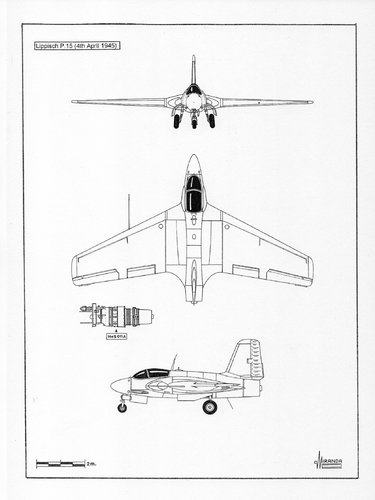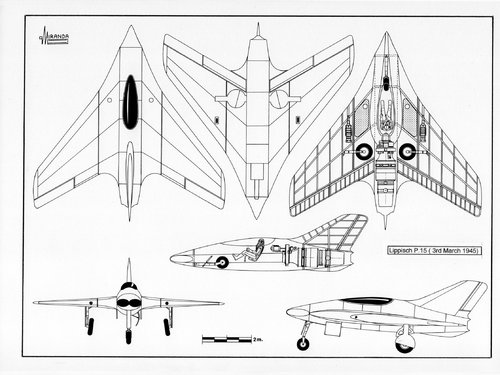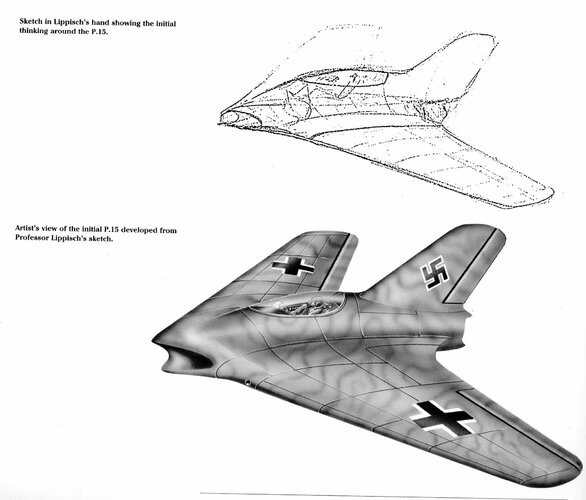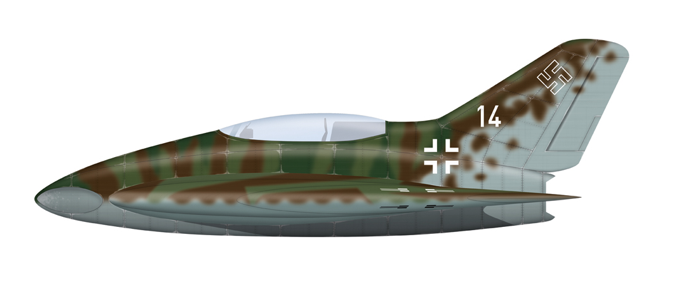- Lippisch P.15
The systematic bombing of the German industry forced the decentralisation of the aeronautical production in multitude of small plants and workshops that manufactured components.
The chaos produced in the Reich transportation systems during the last months of the war, broke the well ordered production schedule up: some spare parts were scarce, others did not arrive on time to the assembly lines and there was overstock of others.In March 1945 the LFA-Wien decided to make the most of the situation by designing the Frankestein airplanes, built with the surplus parts. The same panic fighter concept used in the design of the North American Fisher P.75 and the Boomerang in Australia.
The Volksjäger of Heinkel, conceived as a fighter cheap to manufacture in large quantities and easy to be operated by young inexperienced pilots, was to be a costly failure. The wooden wing was wrongly designed, the landing speed was excessive, the twin tailfin generated too much drag, penalising performances, and the fuselage design did not allow the installation of heavy guns.
On 4 March 1945, the Lippisch design team proposed to the OKL to create a special assembly centre in the Wiener Neustadt Works (WNF) destined to the manufacturing of the P.15 fighter Diana. It was an airplane easy to operate, as stable at low speed as the Komet, able to transport 30 mm guns and to fly faster and higher than the He 162, although being powered by the same engine.
The P.15 used the frontal three quarters of the He 162 fuselage - there was an excess of production in the Khala subterranean complex- the wooden wings of a Me 163 B –from which there were many spares- the tailfin of a Junkers 248, the electronics of a Me 262 and the undercarriage of Salamander. The WNF just should build the central section of the wing, the air intakes and the internal air ducts. The installed engine could be a Jumo 004, a BMW 003 or one of the new HeS 011.
Wind tunnel tests made with a 1:25 scale model proved that the airplane was stable up to a critical number of 0.84 Mach. The little experiment served to prove the concept was effective and Lippisch used it again for the design of the transoceanic version (P.15, 3 March 1945) that combines different elements used in the Messerschmitt projects on which Lippisch had cooperated.
The 52º swept wing was an adaptation from the one at the Me P1112 S/2 (3 March 1945) the air intakes were based on the LP13 and Me P1092 (16 July 1943) whereas the tailfin and the canopy came from the LP14 and LP12 respectively. The air came from the turbojet through the S shaped pipes that surrounded the cockpit, passing across the wing roots. The armament was reduced to just two MK 108/30 cannon in the wing roots and the electronic equipment would be the same than the one developed for the Ju 248.
Technical data Lippisch P.15 Diana (4 April 1945)
Type single seat jet fighter
Wings wood structure and cladding, 23º swept, aspect ratio 5:1
Fuselage metallic structure and cladding, non-pressurised cockpit, Heinkel Kartusche ejector seat
Landing gear tricycle type, from the He 162
Engine one Junkers Jumo 004 or one BMW 003 rated at 800 kp or one HeS 011 rated at 1,300 kp static thrust.
Fuel tanks in the fuselage, behind the pilot
Armament two MK 108/30 cannons in the wing roots and two MG 151/20 cannon in the nose
Wingspan 10.08 m
Length 6.40 m
Wing area 20 sq.m
Max. speed (with HeS 011) Mach 0.84
Endurance (with HeS 011) 45 min
Technical data Lippisch P.15 (3 March 1945)
Type transonic jet fighter
Wings 52º swept back and a 7º thickness/chord ratio, metallic structure and cladding
Fuselage integrated in the wing, pressurised cockpit, metallic structure and cladding,
Landing gear tricycle type, based on the Messerschmitt P1112 S/2 one
Engine one HeS 011 turbojet of 1,290 kp thrust.
Fuel tanks two in the wings
Armament two MK 108 cannons of 30 mm in the wing roots
Wingspan 7.80 m
Length 8.10 m
Height 2.90 m
Wing area 22 sq.m
Max. speed Mach 1
Attachments
Last edited:




